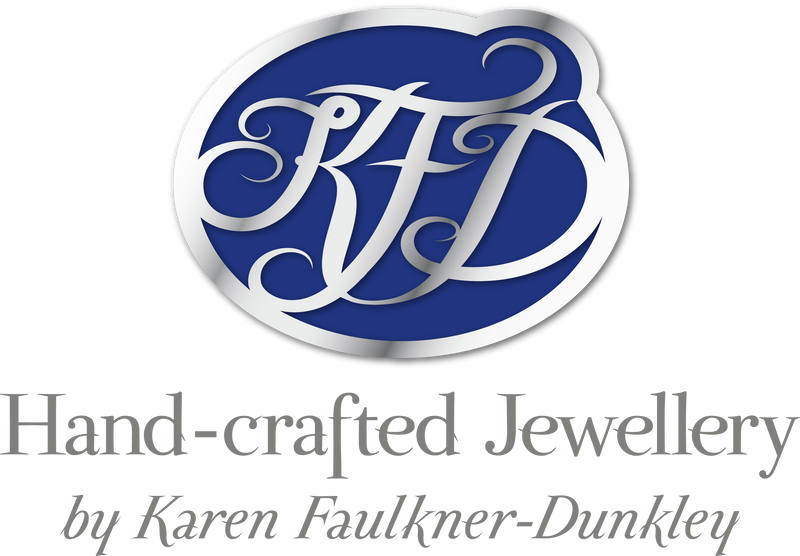What is KFD Jewellery made from?
Almost all KFD Jewellery is made from sterling silver. Some jewellery collections have a mixture of sterling silver with 9ct gold (e.g. Classic Leaf and some Jenyus). Some collections (Champagne) are sterling silver with gold plate. Both 9ct gold only jewellery (e.g. Small Orchid pendant) and 18ct only gold jewellery (Orchid pendant) is available. More recently 24ct gold vermeil has been added to several collections.
Is all KFD jewellery hallmarked?
All the gold only jewellery is hallmarked and the silver jewellery that weighs more than 7.78g.
In the UK all silver weighing more than 7.78g must be hallmarked. All gold over 1g and all platinum over 0.5g must also be hallmarked.
What is the difference between a hallmark and a numbered stamp e.g. 925?
A 925 stamp is a fineness mark that the jeweller stamps onto a piece of jewellery to state that it has been made with 925 sterling silver (925 parts per thousand). A 925 mark DOES NOT prove that the jewellery is sterling silver. If a piece of jewellery has been hallmarked it has been assayed and tested by experts at the assay office. It is the assay office which then applies the hallmark stamp to verify that the material is what the jeweller says it is.
For further information about the hallmarking process click on this link:![]()
What are the hallmarks you use?
All UK jewellery must be stamped with the makers mark, known as the sponsors mark, Mine is KFD , the millesimal fineness mark - 925 in the case of sterling silver, and the assay office mark - a jaguar head for London, an anchor for Birmingham, a rose for Sheffield and a castle for Edinburgh.
![]()
![]()

The London assay office, as standard also included the traditional fineness mark and the date mark. So all hallmarked KFD Jewellery has 5 stamps:
![]()
![]()
![]()

![]()
How is jewellery that is a mixture of silver and gold hallmarked?
Our Classic leaf torques are a mixture of sterling silver and 9ct gold. The full hallmark denoting sterling silver is stamped onto the silver part and a minor, fineness mark, 375 is stamped onto one of the gold leaves.
For further information about hallmarking
All our products are hallmarked
KFD jewellery products are genuine, and each product is hallmarked with the appropriate marks.
How do I clean my jewellery?
This question is asked all the time! There are a variety of methods of cleaning silver, but the very best advice I can give is to keep it clean and not let it get very tarnished in the first place.
Tarnish is a black/ grey layer that forms on the surface of silver when the silver reacts with sulphur compounds in the air. Perfumes, moisturisers and deodorants can all contribute to tarnishing. Silver tarnishes also occurs more rapidly in areas with high humidity and high air pollution.
It is not really possible to prevent silver from tarnishing , but it is possible to slow down the rate of tarnish by observing the following guidelines:
1. Don't wear your silver jewellery whilst taking a bath or shower.
2. Develop a habit to ensure that your jewellery is the last to be put on and the first to be taken off.
3. Do not apply creams or lotions, or spray deodorants or perfumes whilst wearing your jewellery
4. The most important tip is to keep your silver clean. Use a silver cloth at the first sign of tarnish rather than allowing the tarnish to build up. Like most things prevention is usually the best course of action.
How you store your jewellery is also important .Store your jewellery carefully, ideally away from moisture and light.
My jewellery stays tarnish free by keeping it in the safe in plastic bags in a dark safe. Storing it with little bags of silica gel can help too.
Try a silver cloth or silver polish first if your jewellery is only very lightly tarnished. If this doesn't remove the tarnish try one of these other methods.
1. Basic method using household ingredients
2. How to clean textured silver jewellery
3. How to clean pearl jewellery
4. Using an ultrasonic to clean jewellery
How often do my pearls need re- stringing?
It depends very much on how often you wear them. The silk threads stretch and weaken over time -whenever this occurs have the pearls re-strung. If you wear your pearls every week you will probably need them restrung once a year.
How can I pay for my purchase?
It is really easy to pay online line. You can pay by Paypal or use Visa, mastercard or delta.
What happens if I don’t like the when I receive it?
No problem, return the jewellery within 28 days and monies paid for the jewellery will be refunded.
I love the jewellery , but it doesn’t fit me properly. Can anything be done?
Yes, call or email our office and we will resolve the problem.
How long does delivery take after placing an order?
Items that are in stock will usually be dispatched on the day of the order, as long as you order before 12.00 midday. At busy times dispatch maybe take 2 -3 working days. Items that are out of stock or are made to order will normally be made and dispatched within 2 weeks.
For more details, view our Shipping & Returns page.
I can’t wear silver, can your jewellery be made in other materials?
All KFD Jewellery can be made in 9ct or 18ct gold to order. Please contact the office for a quote.
How can I find out my ring size?
View our sizing page to find out your ring size. You can also find details or wrist and Torque sizes.

